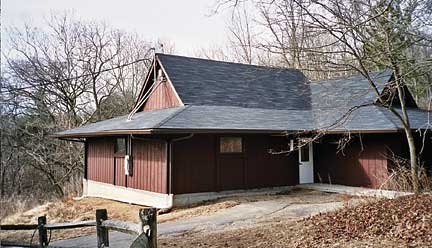"At first we thought that a new carpet was responsible for IAQ problems in our therapy building," explained Susan I. Radabaugh, executive director at Stepping Stones. When the situation failed to improve after treating the carpet, Radabaugh called in the H.C. Nutting Company (HCN), a local engineering firm specializing in environmental testing services.
"HCN noticed that the HVAC unit was serviced through an outside door that faced a wooded area behind the building. The walls around the unit were moist and moldy, and the unit was sucking up mold from that area and circulating it through the building," she said.
As soon as mold was discovered, Stepping Stones shut down the building and moved operations to a different location on the campus.
"We needed to find a way to clean it up and fix the problem," said Radabaugh. "HCN prepared an evaluation in which they recommended extensive remedial measures, including some costly renovation work and replacement of the ducts."

Tackling Mold
One of the Center's trustees, Richard Benner, told Radabaugh of a technology from Steril-Aire Inc. (Cerritos, Calif.) that uses high-intensity ultraviolet light in the C band (UVC) to control mold and other microbes in HVAC systems."Mold in HVAC systems is traditionally addressed through the use of chemicals or through pressure washing of the coils," said Benner, whose company, Superior Air Systems Inc., Cincinnati, has been marketing the Steril-Aire devices for several years.
"But these remedies are costly, are sometimes toxic themselves, and are temporary at best because mold usually returns within a short time. UVC offers a permanent cure by delivering a safe and continuous form of source control.
"In buildings that have used UVC for a number of years, facility managers report that mold in their air-handling systems has been virtually eliminated - along with the need for regular cleaning of coils and drain pans. Also, a research study in a large building showed that the devices were 99 percent effective in removing both surface and airborne mold."
Superior Air and Steril-Aire offered to donate the UVC lights to Stepping Stones and remove them if they were not deemed successful. Superior Air installed residential-style Steril-Aire UVC fixtures in the five-ton system in 2002.
Subsequent environmental testing by HCN found that "the swab sample collected in the cooling coil chamber receiving direct UV exposure had the lowest concentration (and fewest species) reported. In addition, an indirect positive impact may have been achieved downstream with UV radiation potentially inhibiting additional microbial loading."
Other Remedial Measures
UVC light cannot effectively kill mold that has proliferated upstream of the system; thus, it was necessary to replace some sections of contaminated drywall and insulation. An inside entry to the HVAC system was created to close off the original source of moisture, and the system was upgraded with higher efficiency air filtration."Though we did have to take these steps, the UVC lights reduced the need for several other remedial measures," said Radabaugh. "We originally thought we'd have to replace all the ductwork, but we were able to just clean the existing ducts instead. We also found that we would not need to tear out extensive areas of the back wall and ceiling as originally anticipated."
During the investigative phase, Stepping Stones raised funds to cover the projected remediation costs. When they found that the actual costs would be considerably lower, they were able to use the funds instead to expand and upgrade the building. The newly renovated building is now twice its original size and will reopen in the summer of 2004 as a specialized therapy center for children with disabilities.
"We're delighted that the UVC lights took care of our problem and enabled us to perform this expansion," Radabaugh said.
Radabaugh said the center is looking into adding UVC lights to the remaining buildings.
"We've heard from other schools that the lights also do a great job of preventing the spread of infectious diseases, with resulting reductions in illness and absenteeism," noted Radabaugh.
For further information, call 562-467-8484 or visit www.steril-aire.com.
Publication date: 08/09/2004

Report Abusive Comment